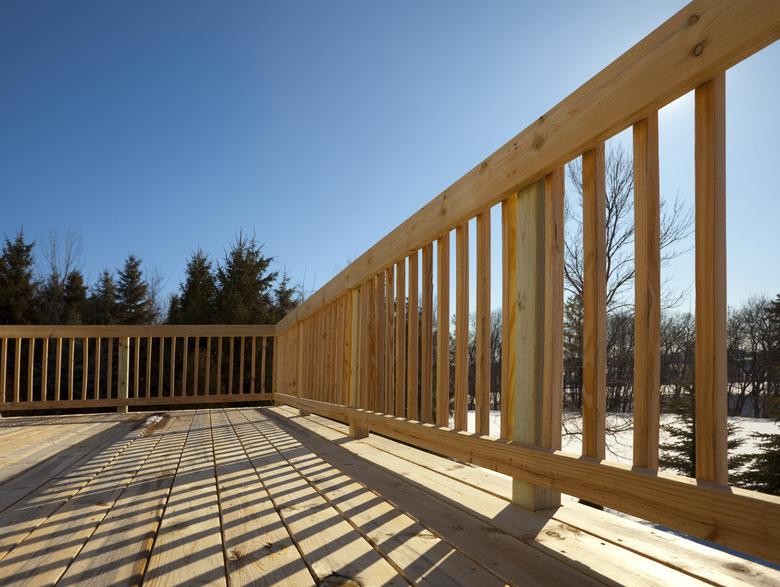How To Add A Rail To An Existing Deck
We may receive a commission on purchases made from links.
A deck handrail is a basic safety feature that can improve both the appearance and the usability of your outdoor deck, and depending on the height of the deck, it may be a code requirement. Deck handrails are typically constructed of wood and consist of a post and rail system, with decorative balusters to fill the open space between posts. Handrails can be constructed in any number of styles, but a basic handrail can be installed by the average do-it-yourselfer with some basic tools and a good, clear plan.
Things Needed
How to Add a Rail to an Existing Deck
1. Determine the Number of Rail Posts
Check the local building ordinances and regulations for guidelines as to the required height and materials for your deck handrail. Inspect your deck, and determine the number of rail posts and the proper placement before beginning the job. Rail posts should be set at each corner as well as at the top of deck stairs and should be no more than 6 feet apart at the center line. Factor in stairways and openings where a rail will not be needed.
2. Cut the Deck Posts
Cut all 4-by-4 foot wooden posts to a length of 48 inches using a table saw or circular saw. You might need to cut the posts longer based on local building codes and your selected railing height. In most areas, the code requires a minimum height of 36 inches from the top of your deck boards to the top of your railing, but some areas have higher requirements. For third-story or higher decks, the height minimum usually increases to anywhere from 42 to 48 inches. Each store-bought post should make two full railing posts if you use the 48-inch measurement.
3. Position the Posts
Place your first post at one corner of the deck. Temporarily fasten the post in position with screws so that the bottom of the post is flush with the bottom of the deck rim. Use a level to check that the post is perfectly straight, and adjust as needed.
4. Attach the Posts
Make two holes through the post and deck rim behind it using a drill and a 1/2-inch spade bit. Stagger the holes so that they're not directly next to one another as this would weaken the joint. Insert 1/2-inch through bolts, with one washer on each side, and fasten in place using a wrench or ratchet set. Repeat the process around the entire outer rim of the deck wherever you wish to install your railing.
5. Cut and Attach Top Board
Record the distance between the bottoms of two of the posts you installed with a tape measure and cut a 2-by-6-inch board to fit the gap. Use a tape measure and pencil to mark the post 34 1/2 inches up from the surface of the deck. Tap the board into place with a hammer so that its top edge touches the mark and its inner edge is flush with the inside edge of the post, then screw the board securely in place. Drive one screw at a downward angle from the top of the board, and drive one at an upward angle from the bottom of the board on each end.
6. Cut and Attach a 2x4 Stud
Cut a 2-by-4-inch stud to the same length as the 2-by-6-inch board. Place the stud atop the board you have just mounted, and fasten it to the board using deck screws. Space the deck screws by 16 inches.
7. Cut the Spindles
Record the distance between the bottom edge of your 2-by-4-inch stud and the bottom edge of the deck rim, using a tape measure. Cut all of your spindles to this length. Make one hole on the side of each spindle about 1 inch from the top and 1 inch from the bottom, using a drill and countersink bit. Make a second hole about 3 inches below the first at the top and about 3 inches above the first at the bottom.
8. Mark the Spindle Locations
Find the center point of the 2-by-6-inch board and mark this location with a pencil, then mark the board every 5 inches on both sides of the center point until you reach the posts at each end. If you have less than 2 1/2 inches between your post and the mark closest to it, reset your marks 2 1/2 inches closer to center. This will create a more pleasing visual effect. In most areas, deck building codes require no more than 4 inches between the spindles. By marking every 5 inches, you leave room for the spindle if it's at least 1 inch wide while sticking to the 4-inch maximum gap. You can adjust the spindle spacing marks so they're closer if you prefer.
9. Attach the Spindles
Place one spindle on each of your marks at the center point. Install one deck screw in the uppermost hole using a screw gun. Use a level to check that the spindle is straight. Fasten the spindle in position using your screw gun and deck screws. Complete the same process with all spindles.
Tip
Deck railings can be attached in many ways, but when dealing with a pre-existing deck, outside posts are often the most efficient way to go.
Lay your cut spindles out, and use a uniform measurement to mark the screw holes. Aligning all the spindles at once can prevent errors in the hole locations.
Place copper post caps atop your deck posts to create a more finished look.
Warning
Always wear eye protection and work gloves when using dangerous tools such as saws, hammers, and screw guns.
